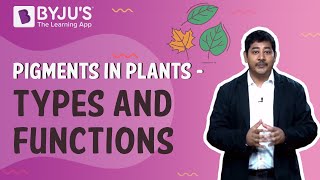Pigments are compounds that give colour to materials around us. The substances that give this colour are also termed as biochromes or biological pigments. They are usually insoluble in water and are of two types – organic (natural) and inorganic (synthetic). Photosynthetic pigments are a type of natural pigment that helps in the process of photosynthesis. Here, let’s discuss more about the different types of photosynthetic pigments.
Table of Contents
- Photosynthetic Pigments
- Groups of Pigments
- Functions of Photosynthetic Pigments
- Frequently Asked Questions
Photosynthetic Pigments
Photosynthetic pigments are the most important coloured components of the chloroplast lamellae. These pigments are molecules that strongly absorb visible light. They interact with sunlight to alter the wavelengths that are either reflected or transmitted by the plant tissue. These pigments are also found in cyanobacteria and algae.
Groups of Pigments
The major groups of photosynthetic pigments are:
- Chlorophyll
- Carotenoids
- Phycobilins
- Flavonoids
Chlorophyll
|
Chlorophyll – Chemical Formula – C₅₅H₇₂O₅N₄Mg |
|---|
The most widespread pigment in photosynthetic plants is chlorophyll. They are cyclic tetrapyrrole pigments chelated with magnesium. They share structural features with the haem and bile pigments of animals. These chlorophyll pigments can be found in fruits, flowers as well as leaves.
Chlorophyll a and chlorophyll b are the major types of chlorophylls found in plants. The former is a blue-green pigment and the latter is a yellow-green pigment. They give their characteristic green colour due to the strong absorbance of red and blue light. The other types of chlorophyll include chlorophyll c1, c2, c3, d, e and chlorophyll f.
Achlorophyllous – Achlorophyllous is a term used to describe an organism without chlorophyll and thus not able to take part in photosynthesis.
Carotenoids
Carotenoids are also associated with the process of photosynthesis. Additionally, they give a bright colour to the fruits and flowers. They are terpenoid pigments present in all photosynthetic plants and they also occur in photosynthetic bacteria such as Rhodobacter and Erwinia. Carotenoids are orange, red and yellow pigments that usually occur in the roots, tubers, leaves, fruits, seeds and flowers.
This group includes the xanthophylls (yellow pigments) and carotenes (orange pigments).
- Zeaxanthin (xanthophyll) – yellow of corn seeds
- β carotene – orange peel
Phycobilins
It is a light-capturing bile pigment found in the chloroplast of red algae and cyanobacteria. They have chromatophores that are primarily responsible for their colour. These are unique pigments as they are bonded to water-soluble phycobiliproteins which pass sunlight to chlorophyll and thus help in the process of photosynthesis.
Flavonoids
Flavonoids are another type of commonly-found pigment, which are phenylpropanoid compounds. There are several classes of flavonoids out of which only a few provide pigments to plants like the proanthocyanidins (condensed tannins) and anthocyanins. Flavonoids occur in almost all tissues. Apart from providing floral pigmentation, they are also involved in nitrogen fixation, physiological regulation, UV filtration, etc.
|
Pigment |
Common Types |
Occurrence |
|---|---|---|
|
Chlorophyll |
Chlorophyll |
All photosynthetic plants |
|
Flavonoids |
Aurones Anthocyanins Flavonols Chalcones Proanthocyanidins |
Common in plants including gymnosperms, angiosperms, bryophytes and ferns. |
|
Carotenoids |
Carotenes Xanthophylls |
Photosynthetic plants and bacteria. |
|
Phycobilins |
Phycoerythrobilin Phycocyanobilin Phycourobilin |
Red algae, cryptomonads, glaucophytes and cyanobacteria. |
Functions of Photosynthetic Pigments
Chlorophylls and carotenoids are required for photosynthesis. Chlorophylls are essential for the capture of light energy and are the primary electron donors. Carotenoids are essential structural components of the photosynthetic apparatus, where they protect against photo-oxidation. Plant pigments are also involved in other interactions of plants with light, in particular, the response to UV radiation.
With the exception of chlorophyll, the most obvious function of plant pigments is to provide colour to fruits and flowers and aid in pollination. Anthocyanins often occur in vegetative tissues. They contribute to the autumn colour in leaves of many deciduous species, which they generate in combination with the retention of carotenoids and loss of chlorophyll. In some cases, anthocyanin production is induced in response to stress like pests, pathogens, cold, nutrient deficiency, etc.
Also Check:
Keep exploring BYJU’S Biology to learn more such exciting topics.
Recommended Video:
